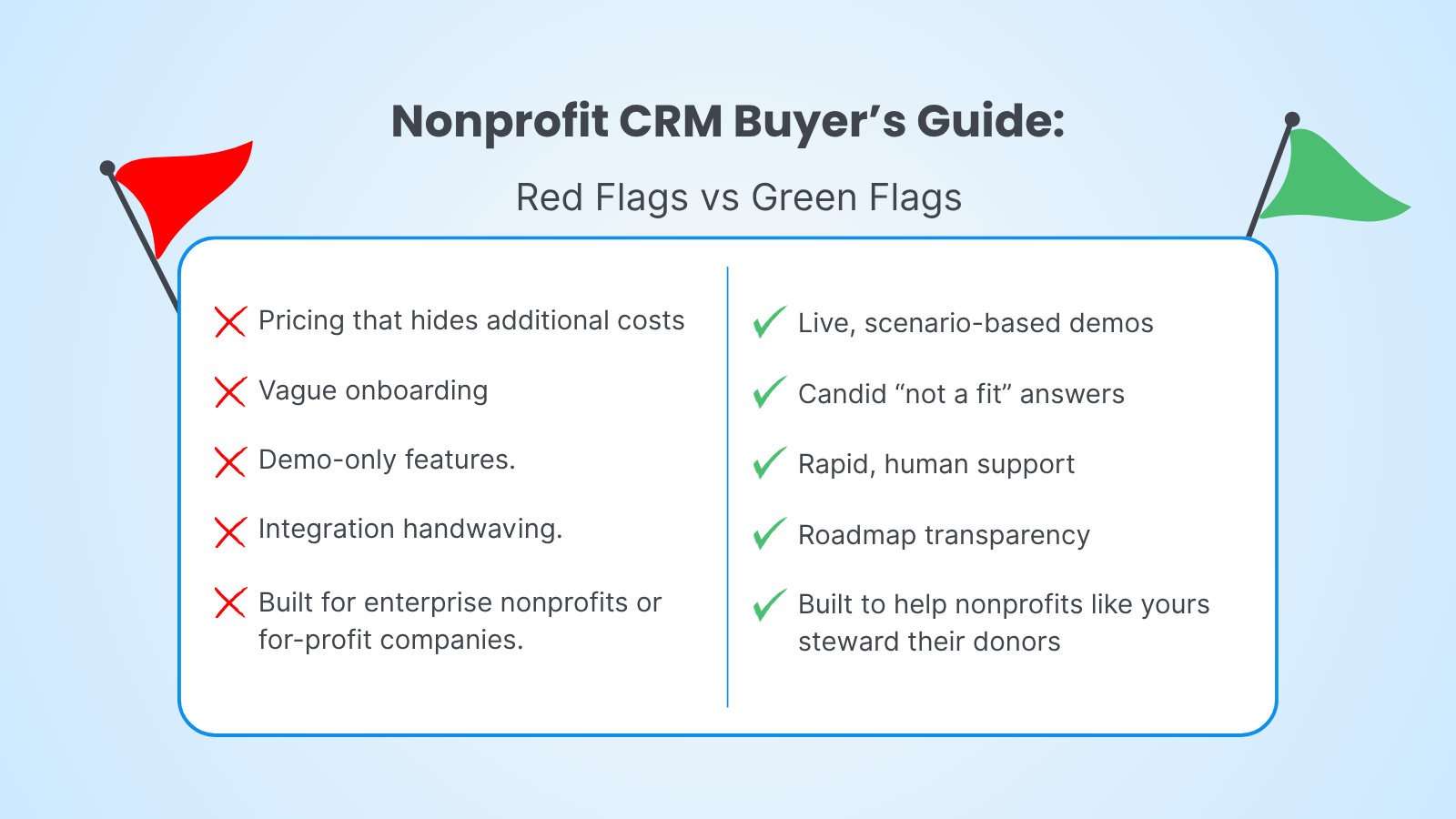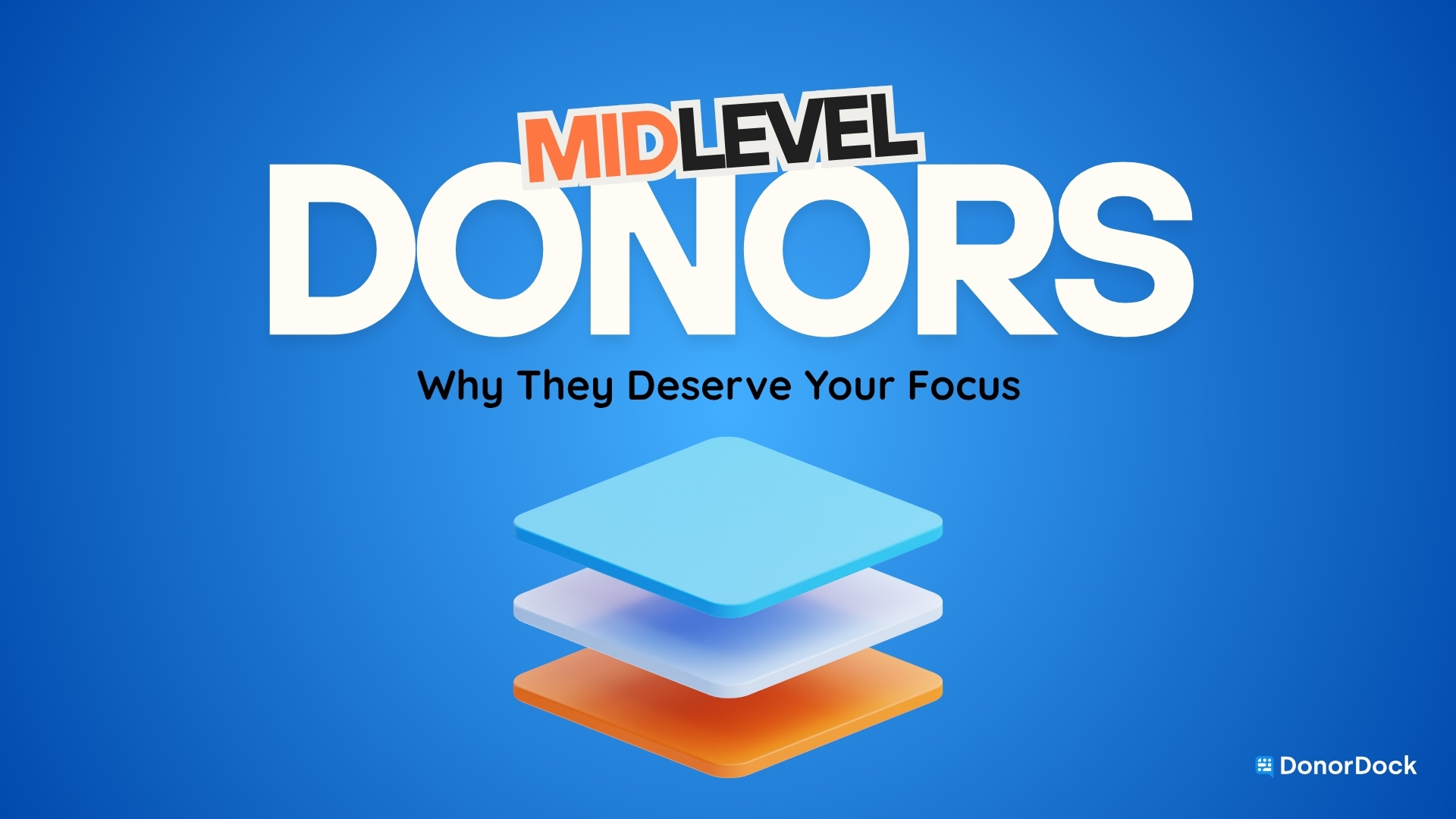When you invest in a CRM or fundraising platform, you are not just buying features. You are choosing people, priorities, and a way of working. The right partner helps your small team focus on what matters most, adopt best practices, and grow confidently without piling on more tools. The wrong one adds noise, creates data silos, and quietly erodes donor trust.
This guide gives you a practical lens to evaluate vendors like a pro. Use it to spot real partners, not just products.
“Tools don’t build relationships. People using good tools do.”
Use tech to amplify habits like clean data, timely follow up, and visible pipeline. For a simple starter, see DonorDock’s idea of a CRM as a force multiplier built on four habits.
Why “partner quality” matters more than feature lists
Plenty of platforms look similar on paper. The difference shows up after you sign: onboarding, data hygiene help, response time, roadmap follow-through, and clear guidance when you are busy.
A few reality checks to keep you grounded:
- CRM implementations fail often. Industry analyses place failure rates in the 30% to 70% range, with one study pegging it at 55%. The common culprit is poor adoption, not missing features. That is why you need a partner who prioritizes onboarding, training, and change management.
- SaaS sprawl is real. Companies averaged about 112 apps in 2023 and 106 in 2024, according to BetterCloud. Fewer apps with better integration beats more tools with more tabs.
- “Free” tools can get expensive. Hidden costs show up in time, security, and fragmented data. Recent guidance warns nonprofits to watch the total cost of ownership, not just the sticker price.
- Shadow IT increases risk and spend. New reports tie unauthorized tools and “shadow AI” to higher breach costs, with global averages climbing when AI is unmanaged. Consolidation and governance protect donors and your brand.
The 12 questions that separate partners from products
Use these in discovery calls and RFPs. Push for concrete answers and live demonstrations, not slideware.
- Who is your leadership team, and how long have they been in place? Why was the company founded?
Tenure and origin story signal staying power and values. You want builders who care about nonprofit outcomes, not just market share. - How are you funded, and how does that shape your next 12 to 24 months of roadmap?
Funding models influence priorities. Ask how revenue, investment, or PE ownership affects release cadence, pricing, and support. - How many active nonprofit customers do you support, and in what segments?
Volume and focus matter. A platform that understands small and midsize teams will design simpler flows and better onboarding. - What does onboarding include, and who does the work?
Find out whether onboarding is DIY, vendor-led, or partner-led, and what “done” means. Get a timeline, deliverables, and named roles. - How is support staffed and measured?
Ask for typical first response and resolution times, coverage hours, and escalation paths. Great partners staff support as a hospitality function, not a cost center. - What does a live workflow look like for us today?
Skip the polished deck. Watch a rep run your top three workflows end to end in the actual product. No demo data. No shortcuts. - Which integrations are native vs. third party, and what data syncs in each direction?
Clarify fields, sync frequency, and error handling. Integration prevents data silos that hurt donor experience and staff time. - What happens to our data if we leave?
Ask for export formats, any fees, and retention timelines. Your data should be portable and human-readable. - How do you help small teams adopt best practices when our process is still forming?
Look for embedded playbooks, automations, and coaching. For example, mapping six core donor segments into journeys can keep outreach human and focused. - What does “good fit” vs. “not a fit” look like for you?
You want a candid answer. Mature partners know where they excel and where they are not the right choice. - Show me a recent example where customer feedback changed your roadmap.
You are testing humility and responsiveness. Platforms that learn will serve you better over time. - What is our year-one total cost of ownership?
Go beyond subscription. Include onboarding, add-ons, integrations, professional services, usage tiers, payment processing, and staff time. The best partners help you anticipate TCO so you are never surprised.
How to run a fair, focused evaluation with a small team
You do not need a six-month roll-out plan. You need clarity and momentum. Here is a simple three-week plan that respects your capacity.
Week 1: Define the jobs to be done.
List the outcomes you must deliver in the next 12 months: track donors and gifts, run targeted outreach, manage events or campaigns, and report what leaders actually use. Keep it tight. Then pull three real records and map the touchpoints you want to see in one place. If a platform cannot make that view easy, move on. For a donor-first rhythm, see Signal vs. Noise: The 15-Hour Focus Framework.
Week 2: Orchestrate live workflow demos.
Give each vendor the same three scenarios and your data snippets. Ask them to show, not tell: entering a gift, launching a segmented email or text, and generating a board-ready report. Time the clicks. Note where the product nudges best practices. Capture gaps and workarounds.
Week 3: Validate support and security.
Open a support ticket during your trial and measure the response. Request documentation on exports, uptime, and incident response. With rising AI and “shadow” tools, ask how they protect donor data and what guardrails they recommend so you do not accidentally create shadow IT inside your development shop. Recent research ties unmanaged AI and unauthorized tools to higher breach costs, so governance matters as much as convenience.
A quick scoring rubric
Give each platform a 1 to 5 score on these five items and total 25 points:
- Adoption enablement: onboarding clarity, training, and change support
- Donor journey visibility: can you see the whole relationship quickly
- Integrated workflows: fewer tabs, better context
- Reporting that drives action: useful in one glance
- Partnership signals: transparent roadmap, honest fit, dependable support
Anything 20 or above is in contention. Below 16 is a risk.
Red flags to catch early
- “Free” pricing that hides maintenance, add-ons, or services. If a deal looks too good, check TCO and security tradeoffs.
- Vague onboarding. If “implementation” is just a kickoff call and a help center link, adoption will stall.
- Demo-only features. If you cannot test it with your scenarios, assume it will not help you this year.
- Integration handwaving. If they cannot show fields and sync behavior, expect manual exports.
- Built for enterprise nonprofits or for-profit companies. If they only “can be configured" to your needs, you will be building while sprinting.
Green flags that predict long-term success
- Live, scenario-based demos with your data and minimal prep.
- Candid “not a fit” answers that show empathy for small teams.
- Rapid, human support with measurable SLAs.
- Roadmap transparency and examples of customer-informed changes.
- Built-in stewardship rhythms that help you keep promises to donors, like the Relationship Loop framework for consistent follow through.

Put it all together
Choosing a platform partner is about reducing complexity, protecting donor trust, and creating momentum. A partner that helps you consolidate tools, keep data clean, and follow a steady fundraising rhythm will pay for itself in saved time and stronger relationships. Start with your real workflows, insist on live demos, and ask the 12 questions until you have straight answers.
Action step: Grab your top three workflows, book two vendor demos, and run the rubric next week. Then pick the partner that helps your team work with more focus, less frenzy.
Want a platform built for small and growing fundraisers with stewardship baked in? Start building meaningful donor relationships today.












